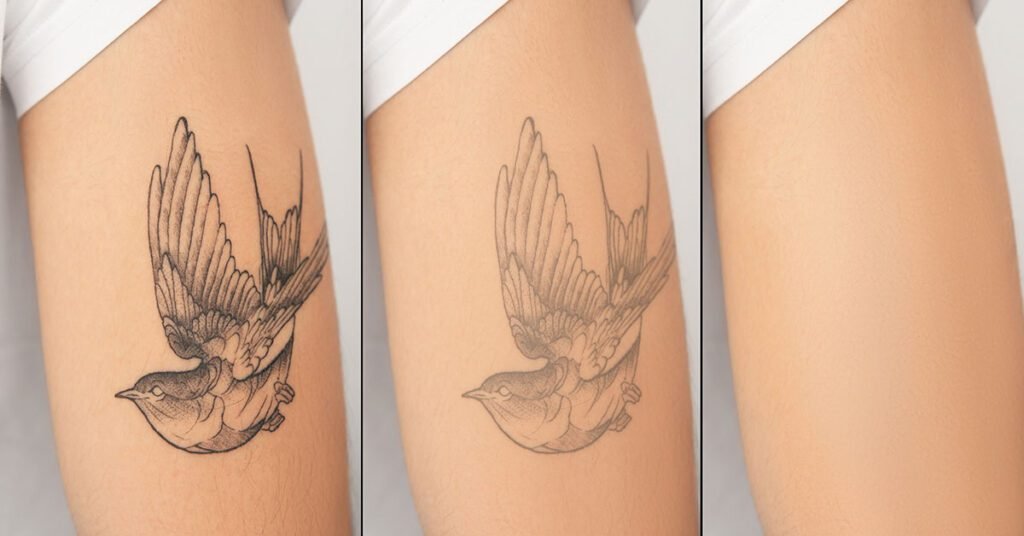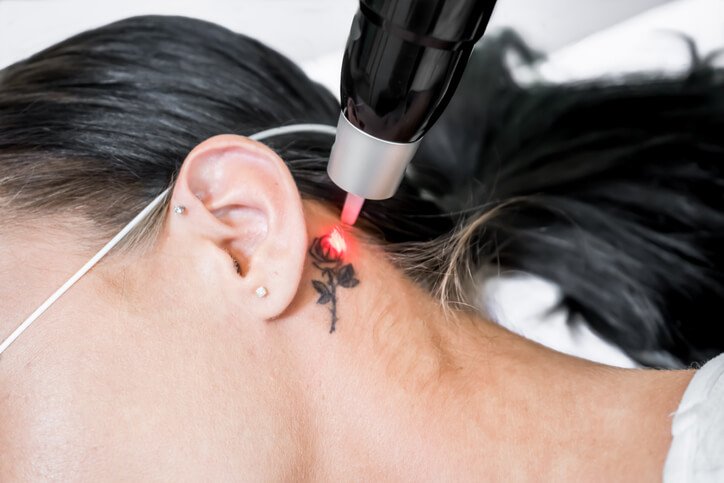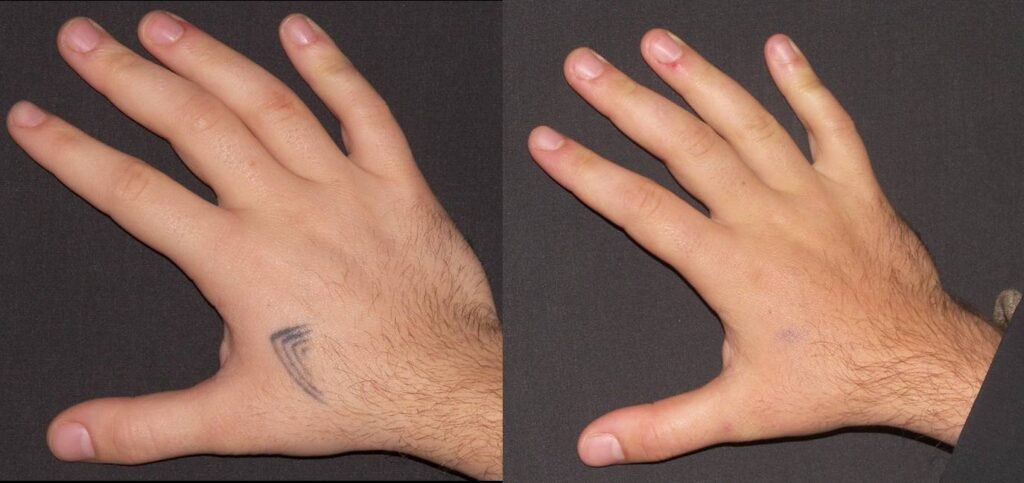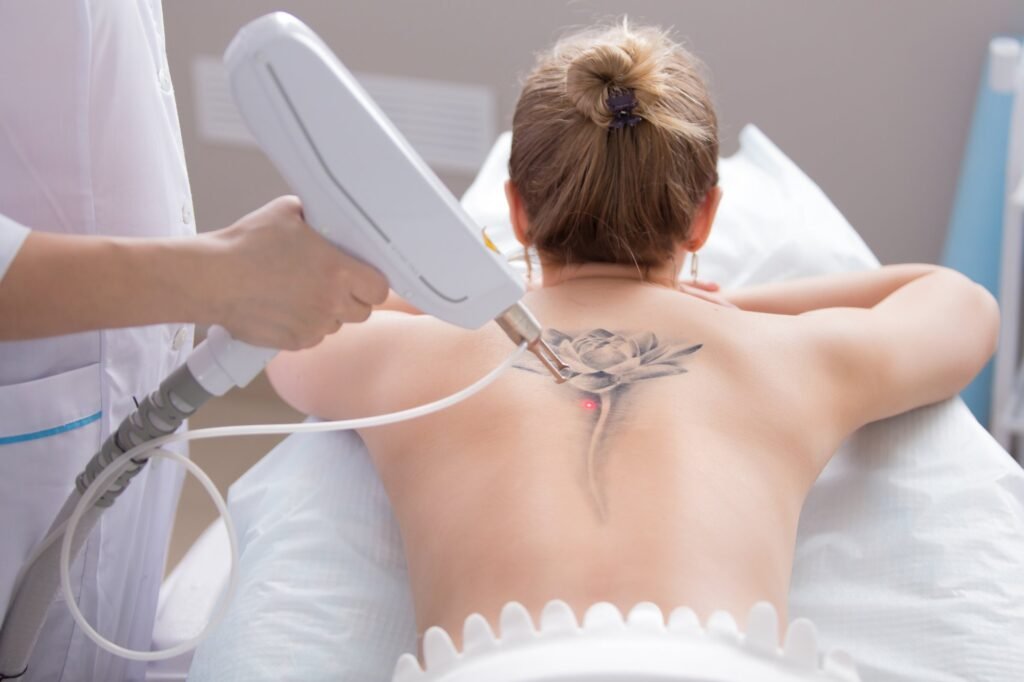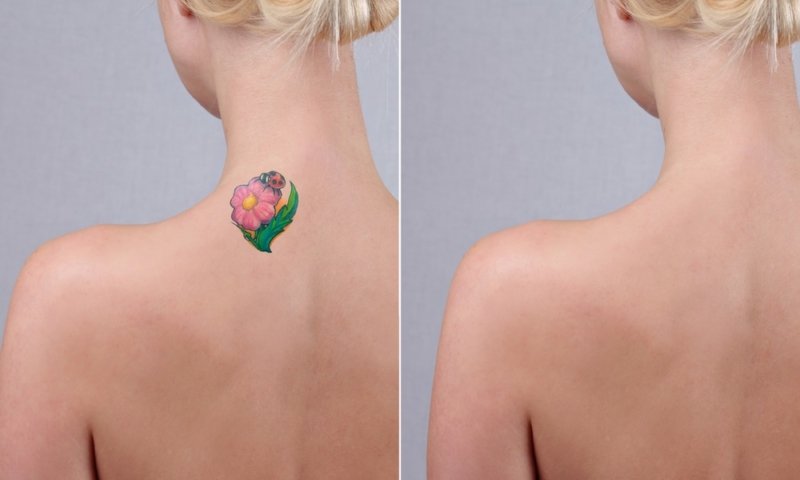With tattoos rising in popularity, so does regret—about 1 in 5 people with ink want to erase it. If you’re stuck with unwanted art, laser tattoo removal is a safe, proven solution, but don’t expect instant results.
As a dermatologist, I often explain that this treatment is a gradual procedure—it breaks down permanent pigment so your skin can naturally remove it. Your healthcare provider may suggest multiple sessions of laser therapy, and while it’s generally safe, possible side effects like scarring depend on aftercare. Patience is key—good results take time.
Overview
What is tattoo removal?
When a tattoo artist injects pigments into your skin, they’re creating a permanent form of body modification. Those vibrant inks and dyes settle deep below the surface, where your immune system can’t easily remove them – the particles are simply too big. This is why professional tattoos last for years, with the granules stubbornly existing in your body. As a dermatologist, I often explain that tattoo removal is a complex process that requires several sessions to complete. The most common method uses laser technology to break down these foreign particles gradually.
If you’re interested in removing an unwanted tattoo, the first step is to talk to a healthcare provider. They’ll help you understand your options and what to expect from the procedure. While it might take time, modern techniques make it possible to significantly fade or even remove tattoos completely. Just remember – what happens during each session depends on your unique skin and the tattoo’s characteristics.
How does tattoo removal work?
The process of tattoo removal works differently depending on the type of treatment you choose. The main goal is always the same: to break down those permanent ink particles your body can’t naturally remove.
Through years of performing laser treatments, I’ve seen how this technology safely fragments ink into smaller particles that your immune system can finally clear away. For many clients, this method offers lower risk of scarring compared to alternatives like dermabrasion, chemical peels, or surgical excision – which focus on removing entire layers of skin containing the ink.
While it takes time (often little more than one year), most people find the wait worth it to get rid of unwanted tattoos. The relief of knowing you don’t have to live with them forever makes the work worthwhile. As your skin heals around the treated area, we can make it look like the tattoo was never there in the first place – though some methods may usually cause more noticeable scarring than others.
Does tattoo removal hurt?
The pain and discomfort you’ll feel during tattoo removal depends on the type of procedure you choose and your personal tolerance. Many people say it feels similar to getting the tattoo in the first place, while others liken the feeling to a rubber band being snapped against your skin. Most clients experience varying levels of soreness after treatment, especially with more painful procedures like laser removal.
That’s why your dermatologist might apply topical numbing cream or inject local anesthetic to ease discomfort—for intense cases, a surgeon may even give general anesthesia. Your skin typically remains tender for a few days, but the results are worth it for those wanting to remove unwanted ink.
Who is a candidate for tattoo removal?
If you have a tattoo you want removed, you might be a good candidate for removal – but there are important factors to consider. First, being in good health significantly improves healing, and non-smokers typically see better results since smoking slows recovery. It’s crucial to have realistic expectations about the procedure; complete removal isn’t always possible, and results vary. You should fully understand the risks and possible side effects before starting treatment, including potential skin changes or scarring.
In my practice, the most successful outcomes come from patients who approach the process with patience and clear goals.
Why do people get tattoos removed?
People choose to remove tattoos for many personal reasons. Maybe you don’t like your ink anymore, or your job doesn’t allow visible tattoos. Often, a tattoo reminds someone of a painful past – someone or something that had a negative impact on their life. From my experience, these are the most common motivations I hear.
Everyone’s reason for wanting removal is unique, but the desire for a fresh start unites them all.
Procedure Details
What are the types of tattoo removal?
Several different types of tattoo removal are available, each with unique benefits.
Laser tattoo removal:
Laser tattoo removal uses focused beams of light that are directed onto the skin, where they heat up the ink particles to break them into smaller fragments. Once shattered, your body’s immune system gradually flushes them away. Since tattoos are layered, multiple therapy sessions are usually needed to fully remove them—how many depends on the tattoo’s size, color, and depth. From my experience, patience is key; each session weakens the ink further, but rushing the process can risk scarring.
Dermabrasion:
If you’re looking for a surgical approach, dermabrasion might be an option—though it’s less common today. This procedure uses a special tool to physically remove the outer layers of skin that contain the tattoo ink, essentially sanding it away. Depending on the depth, you may need a local or even general anesthetic to manage the discomfort.
Since it leaves an open wound, healing takes time, often weeks, and requires careful aftercare to avoid scarring. In my experience, newer methods like lasers often outperform dermabrasion in both safety and results, but for certain stubborn inks or small tattoos, it can still be a viable choice.
Chemical Peels:
While lasers dominate tattoo removal today, chemical peels offer another way to remove stubborn inks. A trained provider will apply a strong acid like trichloroacetic acid, which causes the outer layers of your skin to peel away—taking some ink with it. This method works best for small tattoos with shallow permanent ink. However, it often requires multiple sessions and careful aftercare to avoid scarring. In my practice, I’ve found that while chemical peels can work, they’re usually slower than lasers and carry a higher risk of uneven results.
For deeper tattoos, more intensive methods like dermabrasion—a surgical procedure using a special tool to remove layers of skin—may be needed. This approach requires local or even general anesthetic, leaves an open wound, and takes weeks to heal. Though effective, the time and safety concerns make it a less common choice compared to modern options.
Surgical excision:
For small tattoos that need to disappear completely, surgical excision is often the fastest method—I’ve seen it work well for clients who want immediate results. A surgeon literally cuts out the section of skin that contains the tattoo, then carefully stitches the remaining edges together. While this procedure is highly effective for small designs, it’s not practical for large tattoos, as removing too much tattooed skin can cause excessive scarring. The trade-off? You’ll have a linear scar, but zero ink—something I always discuss during consultations.
Tattoo removal creams:
While tattoo removal creams are easily available for home use, they’re rarely as successful as professional therapies—in my experience, they work slowly and often disappoint. These creams typically contain harsh acids that irritate your skin when rubbing them on unwanted ink, potentially causing damage without guaranteed results. Though tempting for DIY removal, expect months of regular application before noticing faint changes, if any.
What is the process of a laser tattoo removal procedure?
Before your treatment begins, you’ll meet with a trained, certified physician who will evaluate your situation and inform you about the entire process. They’ll examine your skin, ask questions about your tattoo (like whether it was done by an amateur or professional), and review any prior removal attempts. Your provider will measure the size of your tattoo, possibly take a photo to record progress, and choose a personalized plan based on the type, color, and depth of your ink—factors that affect how your body breaks down the pigment.
During the laser session, you’ll wear protective eye shields while the provider tests your skin’s reaction to determine the most effective energy level. The treatment itself consists of placing a hand piece against your skin’s surface and activating the laser light in quick pulses. Smaller tattoos may require fewer pulses, while larger ones need more—but all require multiple visits to fade completely. After each session, your healthcare team will share care instructions to help your skin heal properly. From my experience, patients often expect faster results, but patience is key: the light works repeatedly to break down ink over treatments, and proper aftercare makes all the difference.
Why does it take more than one session to remove a tattoo with laser tattoo removal?
When a tattoo artist applies ink, they deposit it in different layers of your skin. To remove it, lasers must break down the pigment into smaller particles so your body can gradually flush them out. However, this process takes time because deeper ink requires multiple treatments—each session targets a specific layer while allowing the skin to heal between procedures.
Additionally, aggressive removal can cause swelling, blistering, or even superficial scarring. Spacing out sessions prevents long-term damage, like permanently discolored skin. Interestingly, some ink may temporarily alter color as it fades, which is normal. Patience is key—your body needs time to process the ink safely.
Will laser tattoo removal completely remove my tattoo?
The removal process varies per person—some tattoos fade completely, while others leave traces due to colors like red or green that resist lasers. Black and blue ink respond well because they absorb light better, but deep pigment may still be hard to reach. In my experience, even successful treatments sometimes require multiple procedures to clear stubborn dye from the body.
Can I remove a tattoo at home?
While at-home tattoo removals like creams or Sal abrasion might seem tempting, most healthcare providers don’t recommend them. These treatments—whether you rub a cream containing strong chemicals or aggressively scrub salt on your skin—often damage the top layers of skin and cause irritation, pain, or even infection. In my practice, I’ve seen many people who tried to break down their permanent ink at home only to end up with worse results.
The success of these methods varies, but they rarely remove tattoos completely. Instead of risking your skin, visit a professional dermatologist or provider—trying to do it on your own can lead to scarring or permanent harm.
How do I find a doctor to remove my tattoo?
The best way to start your tattoo removal journey is by visiting your primary care provider, who can recommend a qualified dermatologist or surgeon that specializes in these procedures. With several different choices available, I always advise clients to consider all their options through a consultation – getting expert opinions helps determine which type of treatment is best for your specific ink.
How long does tattoo removal take?
The time your tattoo removal will take varies depending on size, color, and location – it could range from a few minutes for laser treatments to several hours for surgical excision. Most people need between six and 12 visits (sometimes more) to see results, especially with darker colors that require several sessions. In my experience, the amount of treatments is different for each person, so always choose a qualified professional who can assess your specific ink.
How do I take care of my skin after tattoo removal?
Your healthcare provider or surgeon will discuss specific instructions for care after your tattoo removal procedure. Immediately post-treatment, apply an ice pack to soothe the treated area, and don’t forget to use a bandage to protect the site. You’ll likely need to apply a topical antibiotic cream or ointment to prevent infection and promote healing.
The next day, you can shower, but avoid scrubbing the affected area. Always cover the healing skin with sunscreen when you go outdoors, and try not to pick at it – this can lead to unwanted scarring. From experience, proper aftercare makes all the difference in your final results.
Risks / Benefits
Is tattoo removal safe?
With newer technology, laser systems have made tattoo removal more effective and safe when performed by a licensed, certified healthcare provider who specializes in these treatments – significantly lowering the risk of scarring. Always remember that while this advice is general, it shouldn’t replace your provider’s specific guidance; for details about your case, arrange a visit with an experienced professional.
What are the benefits of a tattoo removal procedure?
Tattoo removal offers several benefits – it helps you effectively get rid of unwanted tattoos, improve your appearance, and boost self-confidence. Modern laser treatments involve minimal amounts of pain or discomfort, with relatively safe procedures and limited recovery time afterward.
What are the risks or complications of this procedure?
While tattoo removal procedures are generally safe when performed by professionals, they carry potential risks like scarring, infections, skin discoloration, irritation, or rash, along with some pain and discomfort. I’ve seen clients who tried to remove ink by themselves at home – these efforts are often ineffective and can be dangerous to your health, even at a parlor or spa where remedies might seem safer.
That’s why I always recommend visiting a trained dermatologist who can consider your overall health and responsibly guide you toward the safest treatment plan for your specific needs.
Does tattoo removal cause scars?
Some types of tattoo removal can cause scars, but you can significantly prevent this by proper aftercare – keeping your skin clean and following your healthcare provider’s instructions after each procedure or session. In my practice, I’ve seen that careful care reduces the likelihood of scarring dramatically.
Recovery and Outlook
How many sessions does it take to remove a tattoo?
The amount of sessions needed to remove your tattoo primarily depends on its size and color – while black ink responds well, vibrant colors often require many more laser removal treatments (typically between six and 12) to see final results. In my experience, it’s always easier to apply ink than erase it, so talk to your healthcare provider about realistic expectations for your skin.
When To Call the Doctor
When should I see a healthcare provider?
Always visit your healthcare provider if you’re interested in getting your tattoo removed, especially before you undergo any removal procedure. If you experience severe side effects like intense pain or swelling after treatment, go to the emergency room immediately – I’ve seen how quick action prevents complications.
FAQS
How long do tattoo removals take?
A single laser tattoo removal session might take just a few minutes, while surgical excision could require a few hours. Most people need several sessions (typically between six and 12 visits, sometimes more) before they see results, especially if they choose laser treatment.
How long does it take for a tattoo to completely disappear?
Tattoos generally begin to show signs of fading within 5 to 10 years, but this depends on several factors like ink quality (higher-quality inks last longer) and location – areas like hands and feet that get more sun exposure and friction tend to fade faster.
How to speed up tattoo removal?
To speed up your tattoo removal, focus on healthy lifestyle changes that support your body’s natural healing processes – staying hydrated, exercising regularly, and avoiding smoking all contribute to faster ink elimination. Additionally, following a balanced diet, getting enough sleep, and minimizing stress helps boost your immune system and overall health, which positively impacts the removal process.
How quickly do red tattoos fade?
Red tattoo ink typically fades faster than darker colors like black, though the exact time frame depends on various factors – some red tattoos may start to lose vibrancy after a few years while others retain their color for decades.

